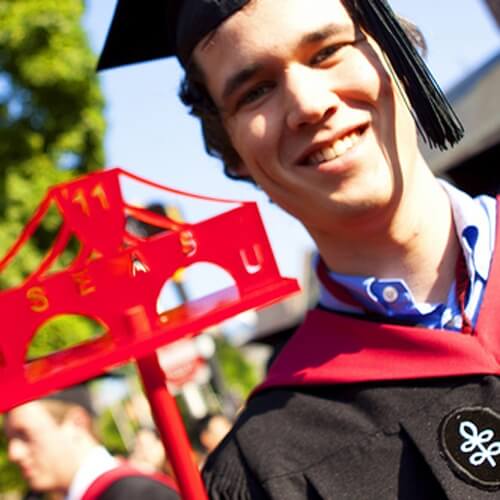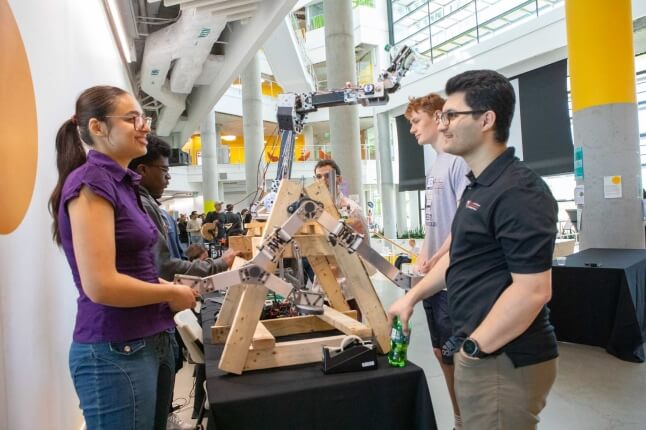News
SEAS alumna Joanne Chang '91, owner of Flour Bakery & Cafe, prepared the enormous cake for Harvard's 375th birthday party in October. (Photo by Rose Lincoln, Harvard News Office.)
Summer 2011
SEAS announced the creation of a graduate secondary field in Computational Science and Engineering.
Jonathan Zittrain, Professor of Law and Computer Science, was named a Distinguished Scholar-Residence of the Federal Communications Commission.
Materials scientists and applied physicists at SEAS created a device that can identify unknown liquids based on surface tension.
Jim Waldo, Gordon McKay Professor of the Practice of Computer Science, was named Chief Technology Officer for Harvard University.
Michelle Borkin (A.B. '06), Erez Lieberman Aiden (Ph.D. '09), and Jean-Baptiste Michel (S.M. '06, Ph.D. '10) presented research on "astronomical medicine" and "culturomics" at TEDxBoston (videos here and here).
A conference at SEAS celebrated the 80th birthday of Professor Michael Rabin, one of the most prominent computer scientists of the past 50 years.
Bioengineers led by Kevin Kit Parker, Tarr Family Professor of Bioengineering and Applied Physics, identified the cellular mechanisms of traumatic brain injury.
September 2011
SEAS announced the appointment of five new faculty members: Ryan Adams, David Keith, Eddie Kohler, Jelani Nelson, and Conor Walsh.
The Science & Cooking Public Lecture Series returned to Harvard, featuring highly popular talks by guest chefs from around the world.
The HIAPER Pole-to-Pole Observations project, led by Professor Steve Wofsy, completed its 3-year series of research flights. The resulting data paint a complete and vivid portrait of the atmosphere.
A. P. J. Abdul Kalam, the former President of India and current Chancellor of the Indian Institute of Space Science and Technology, gave a talk at SEAS on the future of engineering.
Applied physicists led by Professor Federico Capasso and visiting scholar Zeno Gaburro created a new device called a phase mirror, producing bizarre optical phenomena from a flat surface.
(Photo courtesy of Nanfang Yu.)
October 2011
Harvard University celebrated its 375th birthday with a major celebration. Despite pouring rain, faculty, staff, and students glowed with SEAS pride in light-up t-shirts bearing the School's shield.
A team of engineers and physicists led by Marko Lončar captured light in nanoscale diamond pillars and released a stream of single photons at a controllable rate. The achievement represents progress toward quantum computing.
Computational scientists at SEAS demonstrated a new tool called HemoVis, which improves clinical diagnostic accuracy for heart disease from 39% to 91% (compared to traditional methods) simply by changing the graphical presentation of data.
Harvard's deans gathered to cut the gigantic H-shaped cake at the University's 375th birthday party. (Photo by Jon Chase, Harvard News Office.)
November 2011
Facebook founder Mark Zuckerberg returned to campus to recruit computer science students for coveted jobs and internships.
A team of computer scientists at Harvard, BU, and Yale identified a security leak in Yelp's mobile website. (The problem was resolved within a day).
Experts in control systems and robotics developed and successfully licensed a swarm of Kilobots, small autonomous robots that can collaborate to perform simple tasks.
SEAS hosted a week-long symposium, with BASF, on the future of nanotherapies in medicine.
The Harvard Innovation Lab officially opened its doors with a ribbon-cutting ceremony by Harvard President Drew Faust and Boston Mayor Tom Menino.
December 2011
SEAS' most popular Gen-Ed course wrapped up with the annual Science & Cooking Fair, featuring student projects that included tofu pâté, sinking ice, artificial raspberries, and all-egg noodles.
Applied physicists led by Vinothan Manoharan discovered that Pickering emulsions, common in food products and cosmetics, may take years to fully stabilize. The process was thought to be instantaneous.
The CS 50 Fair showed off 677 students' final programming projects in an atmosphere of crowds, laughter, and throbbing music.
(Photo courtesy of Flickr user Daniel Kulinski.)
January 2012
SEAS and Harvard Business School collaborated to take 36 undergraduate and graduate students to Silicon Valley for a week of high-tech company visits, panel discussions, and mentoring.
Engineering students from Brazil and from SEAS traveled to sites on the Gulf Coast and in Massachusetts to learn about environmental engineering directly from professionals in water treatment, flood prevention, and other fields.
Optional Winter Activities Week celebrated passion for teaching and learning, with events including a design workshop led by IDEO, courses on sustainable biomedical materials, aerodynamics, microscopy and imaging, rapid prototyping, and much more.
The Institute for Applied Computational Science hosted ComputeFest, featuring workshops on MATLAB and Mathematica, talks by computational entrepreneurs, and SEAS' first-ever Computational Challenge.
The Experiment Fund launched—a seed-stage investment fund designed to support student start-ups and nurture novel technologies and platforms that got their start in Cambridge.
David Bell was appointed Gordon McKay Professor of the Practice of Electron Microscopy.
Students taking a January mini-course on aerodynamics were treated to one-on-one flight time at Beverly Municipal Airport in Danvers, Mass. Left to right: Pakpong Chirarattananon, Matthias Lorenzen, Xin Li, Xiao Guo, T. Fettah Koşar, and Derek Kenney. (Photo courtesy of Tom Sherwood.)
February 2012
Researchers at Harvard launched the Peer Instruction Network, an online community for educators who are exploring innovative teaching methods that emphasize peer-to-peer interaction.
Professor Joanna Aizenberg gave an engaging talk on "extreme biomimetics" at TEDxBigApple.
Using optical nanoantennas, engineers led by Ken Crozier demonstrated a new kind of tunable color filter that enables precise control of a device's color output.
Engineers led by Rob Wood created pop-up robots to demonstrate a new origami-based method for manufacturing MEMS devices.
(Photo courtesy of Pratheev Sreetharan.)
March 2012
Applied physicists led by Eric Mazur discover a "lucky" combination of chemicals and laser pulses that enables high-resolution, 3D patterning for futuristic optical materials.
Rob Wood received the 2012 Alan T. Waterman Award, the National Science Foundation's most prestigious award for early-career faculty.
The 5th annual Harvard College Innovation (I3) Challenge celebrated student entrepreneurship, awarding up to $50,000 in grants to the winners. A record number of students participated (231 students from 34 concentrations).
April 2012
Students in ES 100, ES 20, and ES 96 showed off their final design projects, tackling problems that ranged from oil spill cleanup to muscular dystrophy, to gang warfare.
Bioengineers and applied physicists used femtosecond laser pulses to cut a cell's mitotic spindle, discovering that the textbook model for spindle formation was incorrect.
Research by climate scientists at SEAS showed that particulate pollution over the eastern United States had created a decades-long "warming hole" that delayed the regional effects of global warming.
(Image courtesy of Julie Eichhorn.)
May 2012
SEAS held its first spring Design Fair, showing off hundreds of projects in engineering, computer science, and applied math.
The Faculty Council of the Faculty of Arts and Sciences approved two new concentrations for SEAS, enabling the creation of S.B. degrees in Mechanical Engineering and Electrical Engineering.
At the SEAS Design Fair in May, Gye Hyun Baek '13 and Madalina Persu '13 exhibited their ES 50 project with course assistant Leonard Kogos '12, right. (Photo by Eliza Grinnell, SEAS Communications.)
Topics: Events
Cutting-edge science delivered direct to your inbox.
Join the Harvard SEAS mailing list.



